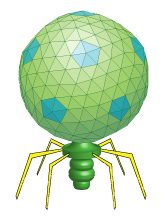

Viruses are obligate intracellular parasites, which means that they have to get inside of a host cell to produce more viruses. The genomes of all viruses, even the biggest ones, do not encode anywhere near the number of proteins that are needed to replicate. The cell provides thousands of proteins that are involved in energy production, membrane synthesis, protein synthesis, transport, and so much more.
The difficulty in studying ancient proteins is that none of them exist. But we can make good guesses about what very old proteins might look like, by examining modern proteins, seeing how they vary among organisms, and calculating how they might look like billions of years ago. The field of predicting what ancient proteins might look like is quite active.
Investigators have predicted what ancient versions of a cell protein called thioredoxin might have looked like. They have synthesized such ‘ancient’ thioredoxins and shown that they are stable and active. Thioredoxins are found in nearly all organisms, where they act as antioxidants.
Ancient thioredoxins that have been synthesized include those from the last common ancestors of bacteria; of archaea; and of archaea and eukaryotes (all around 4 billion years old); the last common anestor of cyanobacterial, deinococcus, and thermus groups (about 2.5 billion years old); the last common ancestor of gamma-proteobacteria; of eukaryotes; and of fungi and animals (around 1.5 billion years old).
These ancient thioredoxins work in a modern E. coli. This bacterium has two thioredoxin genes, and if they are both deleted, growth occurs, but very slowly. If genes encoding ancient thioredoxins are introduced into these mutated bacteria, they can compensate for the growth deficiency. The older thioredoxins (4 billion years) compensate less well than ones that are closer in time (1.5 billion years).
It’s amazing that an ancient protein can work in a modern E. coli. But could ancient thioredoxins support viral growth?
Thioredoxin from E. coli is an essential part of the DNA polymerase complex of the bacteriophage T7 (pictured – image credit). This virus does not form plaques on E. coli lacking the two thioredoxin genes. The only ancient thioredoxin gene that allows phage T7 plaque formation is from the last common ancestor of cyanobacterial, deinococcus, and thermus groups, which is about 2.5 billion years old and has 57% amino acid identity with the E. coli enzyme. But the effienciency of plaque formation was very poor – about 100 million times worse than on regular E. coli. None of the older thioredoxins worked.
Why would an ancient thioredoxin work for E. coli but not for bacteriophage T7? Over billions of years, thioredoxin evolves but it must still be able to carry out its function for E. coli. The viruses that infected bacteria 4 billion years ago were very different from contemporary viruses, and so the ancient thioredoxin does not work for modern viruses. Today’s thioredoxin could change so that it would not support T7 replication – as long as the enzyme still works for E. coli.
The authors of this work view it as a proof of principle: that virus growth is not supported by an ancient version of a modern protein required for virus replication. They would like to apply this approach to produce plants that are resistant to viruses, which have serious effects on global agricultural productivity.
I think the work is amazing not only because an ancient protein can be made, but it supports growth of the host and not that of a virus. It might therefore be possible to reconstruct the host-virus arms race, starting from ancient proteins. In this race, the gene encoding an essential cell protein can evolve so that it no longer supports virus replication. Next, the viral genome changes to adapt to the altered cell protein. And so the game goes back and forth.
The authors have shown that they can select mutant bacteriophage T7 isolates that replicate in the present of an ancient thioredoxin. This result suggests that it might be possible to reconstruct host-virus arms races beginning with an ancestral host protein. If we can make an ancient protein, could we also make an ancient virus? Why not?

Pingback: Ancient proteins block modern viruses - VETMEDICS
Pingback: Ancient proteins block modern viruses - Virology
I don’t think ‘predicted’ is the right word for the speculative process used to arrive at models of what ancient things might have looked like. Predicting the past sounds like cheating. 🙂
How about ‘hypothesised and modelled how ancient proteins might/must have looked.’?
This blog is immensely helpful! My college has been on strike for two weeks (almost three weeks), and I’ve been taking advantage of the extra time to hone my knowledge of viruses.